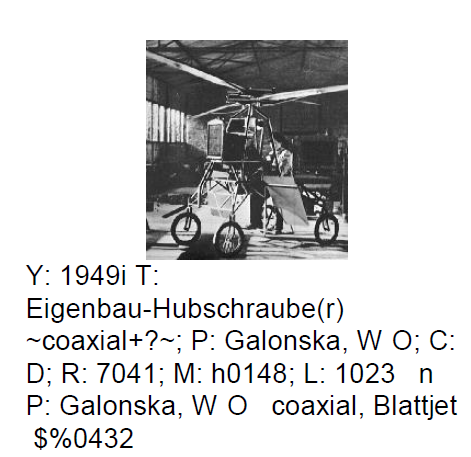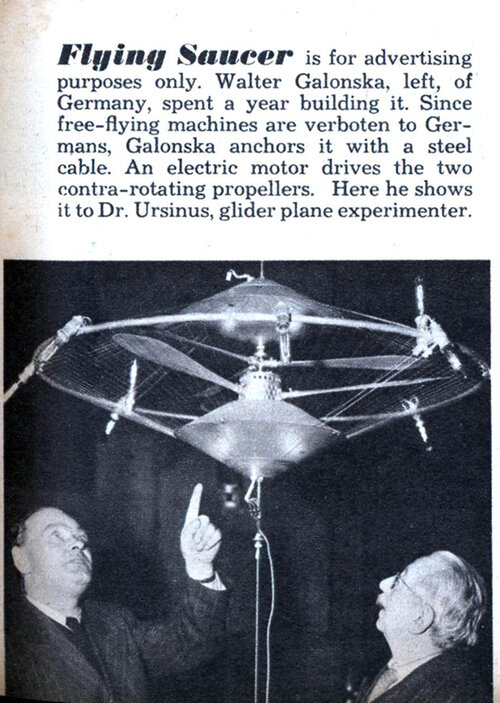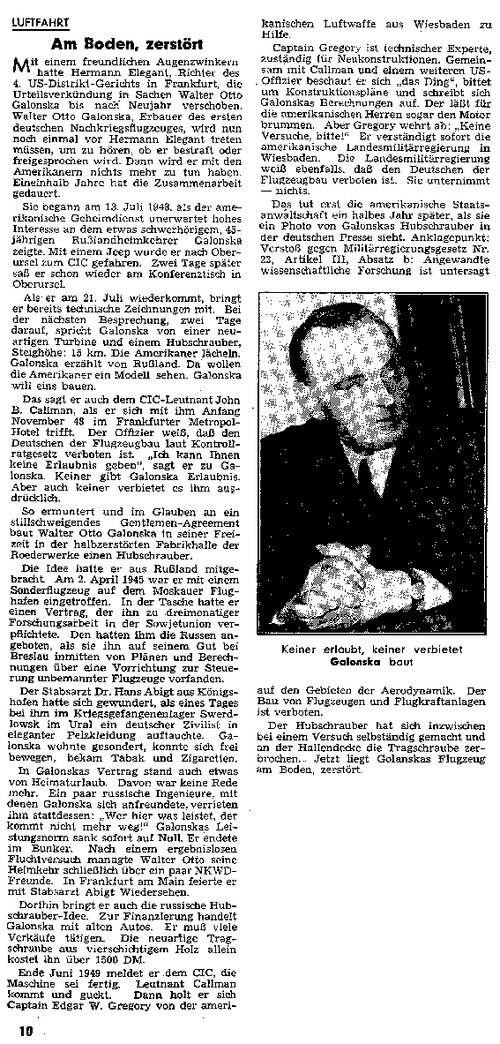You are using an out of date browser. It may not display this or other websites correctly.
You should upgrade or use an alternative browser.
You should upgrade or use an alternative browser.
Walter O. Galonska Helicopter
- Thread starter hesham
- Start date
Armin Derer
In dire need for coffee
- Joined
- 10 June 2021
- Messages
- 70
- Reaction score
- 97
Walter Otto Galonska, pictured in May 1951 issue of Mechanix Illustrated with his "flying saucer", as his electrically powered coaxial drone is referred to.
German news magazine Der Spiegel wrote this in January 1950:
"With a friendly wink, Hermann Elegant, judge of the 4th US District Court in Frankfurt, had postponed the pronouncement of the verdict in the Walter Otto Galonska case until after the New Year. Walter Otto Galonska, builder of the first German post-war aircraft, will now have to appear before Hermann Elegant once more to hear whether he will be punished or acquitted. Then he will have nothing more to do with the Americans. The collaboration lasted one and a half years.
It began on 13 July 1948, when the American secret service unexpectedly showed great interest in Galonska, a somewhat hard of hearing 45-year-old returnee from Russia. He was driven to Oberursel to the CIC in a jeep. Two days later he was already sitting at the conference table in Oberursel.
When he returned on 21 July, he already brought technical drawings with him. At the next meeting, two days later, Galonska talks about a new type of turbine and a helicopter, altitude of climb: 15 km. The Americans smile. Galonska talks about Russia. The Americans want to see a model there. Galonska wants to build one.
That's what he tells CIC Lieutenant John B. Callman when he meets him in Frankfurt's Metropol Hotel in early November 48. The officer knows that the Germans are forbidden by Control Council law to build aircraft. I can't give you permission,' he says to Galonska. No one gives Galonska permission. But no one expressly forbids him either.
Thus encouraged and believing in a tacit gentlemen's agreement, Walter Otto Galonska builds a helicopter in his spare time in the half-destroyed factory building of the Roederwerke.
He had brought the idea with him from Russia. On 2 April 1945, he arrived at Moscow airport in a special aircraft. He had a contract in his pocket that committed him to three months of research work in the Soviet Union. The Russians had offered it to him when they found him on his estate near Breslau surrounded by plans and calculations for a device to control unmanned aircraft.
The staff physician Dr Hans Abigt from Königshofen had been surprised when a German civilian in elegant fur clothing turned up at his home one day in the Sverdlovsk prisoner-of-war camp in the Urals. Galonska lived separately, could move around freely, and was given tobacco and cigarettes.
Galonska's contract also said something about home leave. There was no more talk of that. A few Russian engineers, with whom Galonska became friends, told him instead: Whoever achieves something here will never leave! Galonska's performance standard immediately dropped to zero. He ended up in the bunker. After an unsuccessful escape attempt, Walter Otto finally managed his return home via a few NKVD friends. In Frankfurt am Main he celebrated a reunion with staff doctor Abigt.
That's also where he took the Russian helicopter idea. To finance it, Galonska trades in old cars. He has to make a lot of sales. The new type of propeller made of four-layer wood alone cost him over 1500 DM.
At the end of June 1949, he reports to the CIC that the machine is ready. Lieutenant Callman comes and looks. Then he calls in Captain Edgar W. Gregory from the American Air Force in Wiesbaden to help.
Captain Gregory is a technical expert, responsible for new designs. Together with Callman and another US officer, he looks at 'the thing', asks for construction plans and writes down Galonska's calculations. He even makes the engine hum for the American gentlemen. But Gregory refuses: 'No tests, please! He immediately informs the American military government in Wiesbaden. The state military government also knows that aircraft construction is forbidden to the Germans. They do nothing. The American prosecution did not do anything until six months later, when they saw a photo of Galonska's helicopter in the German press. Charge: Violation of Military Government Law No. 23, Article III, Paragraph b: Applied scientific research is prohibited in the fields of aerodynamics. The construction of aircraft and aircraft power plants is prohibited.
In the meantime, the helicopter has taken on a life of its own during an attempt and has broken its propeller on the ceiling of the hangar. Now Golanska's plane is on the ground, destroyed."
Quite sure the helicopter in question is the one in the previous post.
German news magazine Der Spiegel wrote this in January 1950:
"With a friendly wink, Hermann Elegant, judge of the 4th US District Court in Frankfurt, had postponed the pronouncement of the verdict in the Walter Otto Galonska case until after the New Year. Walter Otto Galonska, builder of the first German post-war aircraft, will now have to appear before Hermann Elegant once more to hear whether he will be punished or acquitted. Then he will have nothing more to do with the Americans. The collaboration lasted one and a half years.
It began on 13 July 1948, when the American secret service unexpectedly showed great interest in Galonska, a somewhat hard of hearing 45-year-old returnee from Russia. He was driven to Oberursel to the CIC in a jeep. Two days later he was already sitting at the conference table in Oberursel.
When he returned on 21 July, he already brought technical drawings with him. At the next meeting, two days later, Galonska talks about a new type of turbine and a helicopter, altitude of climb: 15 km. The Americans smile. Galonska talks about Russia. The Americans want to see a model there. Galonska wants to build one.
That's what he tells CIC Lieutenant John B. Callman when he meets him in Frankfurt's Metropol Hotel in early November 48. The officer knows that the Germans are forbidden by Control Council law to build aircraft. I can't give you permission,' he says to Galonska. No one gives Galonska permission. But no one expressly forbids him either.
Thus encouraged and believing in a tacit gentlemen's agreement, Walter Otto Galonska builds a helicopter in his spare time in the half-destroyed factory building of the Roederwerke.
He had brought the idea with him from Russia. On 2 April 1945, he arrived at Moscow airport in a special aircraft. He had a contract in his pocket that committed him to three months of research work in the Soviet Union. The Russians had offered it to him when they found him on his estate near Breslau surrounded by plans and calculations for a device to control unmanned aircraft.
The staff physician Dr Hans Abigt from Königshofen had been surprised when a German civilian in elegant fur clothing turned up at his home one day in the Sverdlovsk prisoner-of-war camp in the Urals. Galonska lived separately, could move around freely, and was given tobacco and cigarettes.
Galonska's contract also said something about home leave. There was no more talk of that. A few Russian engineers, with whom Galonska became friends, told him instead: Whoever achieves something here will never leave! Galonska's performance standard immediately dropped to zero. He ended up in the bunker. After an unsuccessful escape attempt, Walter Otto finally managed his return home via a few NKVD friends. In Frankfurt am Main he celebrated a reunion with staff doctor Abigt.
That's also where he took the Russian helicopter idea. To finance it, Galonska trades in old cars. He has to make a lot of sales. The new type of propeller made of four-layer wood alone cost him over 1500 DM.
At the end of June 1949, he reports to the CIC that the machine is ready. Lieutenant Callman comes and looks. Then he calls in Captain Edgar W. Gregory from the American Air Force in Wiesbaden to help.
Captain Gregory is a technical expert, responsible for new designs. Together with Callman and another US officer, he looks at 'the thing', asks for construction plans and writes down Galonska's calculations. He even makes the engine hum for the American gentlemen. But Gregory refuses: 'No tests, please! He immediately informs the American military government in Wiesbaden. The state military government also knows that aircraft construction is forbidden to the Germans. They do nothing. The American prosecution did not do anything until six months later, when they saw a photo of Galonska's helicopter in the German press. Charge: Violation of Military Government Law No. 23, Article III, Paragraph b: Applied scientific research is prohibited in the fields of aerodynamics. The construction of aircraft and aircraft power plants is prohibited.
In the meantime, the helicopter has taken on a life of its own during an attempt and has broken its propeller on the ceiling of the hangar. Now Golanska's plane is on the ground, destroyed."
Quite sure the helicopter in question is the one in the previous post.
Attachments
Last edited:



